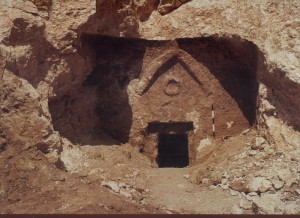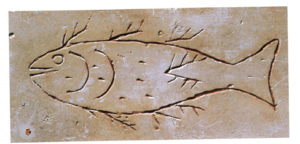Upside Down Fish
In 2007, we identified the real tomb of Jesus in Talpiot, Jerusalem. This upset a lot of people because they would like the tomb to be under the Church of the Holy Sepulchre in Jerusalem. The “logic” goes this way: the tomb of the Holy Sepulchre is Jesus’ tomb because there’s nothing there. Since Jesus left the tomb 3 days after his death, and rose to heaven 30 days after his resurrection, the proof that the Church of the Holy Sepulchre is Jesus’ tomb is that it’s totally empty. For his part, Jesus is in heaven, body and all.
This form of argument is not only convincing for Christian believers but for Israeli archaeologists such as Amos Kloner, Shimon Gibson and my friend Danny Bahat. They think that the Church of the Holy Sepulchre fits nicely with Jesus’ burial, despite the fact that there is zero evidence to that effect.

For my part, I like the tomb in Talpiot. After all, to begin with, there’s a tomb there. Not only that, it has a unique symbol on its façade. Furthermore, it actually had bone boxes (limestone coffins) in it when it was discovered. Meaning, it wasn’t empty. It was full of archaeological stuff. Out of the ten ossuaries that were discovered, six were inscribed with names. Unlike the Church of the Holy Sepulchre, where there are no ossuaries and no inscriptions, this tomb had a certain “Jesus, son of Joseph” buried there. Next to him there was a “Maria”. Next to her, there was a “Yose”, a name specifically linked to one of Jesus’ brothers (Mark 6:3, Matthew 13:55). Next to them, there was a “Mariamene”, a Greek version of “Mary” that in all of Greek literature is associated with Mary Magdalene and no one else. You’d think that someone would find all this compelling. It’s certainly better than zero evidence under the Church of the Holy Sepulchre, isn’t it? But, no. The naysayers accuse me of sensationalism.
So with the naysayers booing from the stands, we proceeded to investigate the tomb next to the Talpiot Jesus tomb. This so-called “Patio Tomb” which remains sealed under a patio could not be excavated because of Haredi (ultra Orthodox) opposition. So we built a robotic arm that allowed us to photograph without excavating. The HiDef GE camera at the end of a specially designed robotic arm gave us a unique look at the ossuaries still inside the Patio Tomb. One ossuary has inscribed on it the only statement of resurrection faith ever found on any ossuary in the land of Israel. The discovery was met with a deafening silence. Another ossuary has a cross on it, but the naysayers said that the cross was not a Christian symbol prior to the 4th century. Nevermind that Christian crosses were found in a 1st century bakery in Pompeii and in a chapel in Herculaneum…the cross is not a cross, it’s a door.
We then found a fish spitting out a stick figure. This is the “Sign of Jonah”, the most prevalent Biblical image used by Christians in Rome’s catacombs… only our image is 200 years earlier than the catacombs. Applause? No, derision.
The naysayers say that the Jonah image is not a Jonah image, nevermind that it actually says “Yonah” on the fish. Obviously, the ancient artist anticipated my critics. So he wrote “Yonah” i.e. “Jonah” on the fish. But if it’s not a Jonah image, at the very least the image carved in the ossuary is a fish. After all, the fish is the earliest of Christian symbols.
At this point, we ventured into an Orwellian universe where the sleeper agents of Christian theology declared the fish to be a vase. I’m not kidding. My kid can see it’s a fish, but these theologians armed with Ph.D.’s can only see vases. Their main argument is that the fish is vertically inscribed on the ossuary, and since fish cannot be “upside down”, the image we uncovered must be a plain, old 1st century vase – not a fish. Basically, according to these people a fish is not a fish when it’s upside down.
What do you know? I ran into an image of an “upside down” Christian fish from a 4th century mosaic in the catacombs of Hermes, Sousse, Tunisia
For the benefit of my non-Orwellian audience, I also provide an image of a fish from a funerary context from 2nd-3rd century CE Rome.
Finally, here is the earliest Christian symbol ever found – by yours truly and team – from Talpiot, Jerusalem.
But you know what? Maybe it’s not a fish. Maybe somebody was buried next to the tomb of “Jesus, son of Joseph” with a picture of a flying vase on his coffin. After all, if it’s a vase, all is well. But if it’s a fish, that means that the Church of the Holy Sepulchre is empty for a reason – Jesus is buried in Talpiot.
Click here to see my recent article “Once again vindicated!” on The Times of Israel




